| Article ID | Journal | Published Year | Pages | File Type |
|---|---|---|---|---|
| 639440 | Journal of Membrane Science | 2006 | 14 Pages |
The utility of a laboratory diagnostic approach was investigated for a systematic evaluation of the impact of operating conditions, membrane type, and antiscalant effectiveness on membrane mineral salt scale formation. The study focused on low-pressure reverse osmosis (RO) membrane desalting of brackish water with high potential for scaling by calcium sulfate dihydrate (gypsum). Gypsum scale formation, in the surface crystallization regime, was studied in a plate-and-frame RO system via flux decline measurements and membrane surface imaging. Membrane scale coverage increased with increasing level of surface gypsum supersaturation. However, membrane scaling propensity, as quantified by both the surface scale coverage and flux decline, indicated that there were measurable differences among the four commercial membranes studied, particularly in response to antiscalant treatment. Axial development of scale coverage indicated higher scale coverage as the membrane channel exit was approached, consistent with increased level of gypsum supersaturation along the membrane. As a result, antiscalant effectiveness, at a given dosage, was also location dependent. The present study illustrates a practical approach of combining flux decline and surface scale coverage measurements as a means of quantifying the impact of scale formation and its dependence on operating conditions and membrane type. Clearly, further studies are needed to elucidate the impact of membrane surface roughness and charge as well as module geometry on surface mineral salt scale formation and its mitigation.
